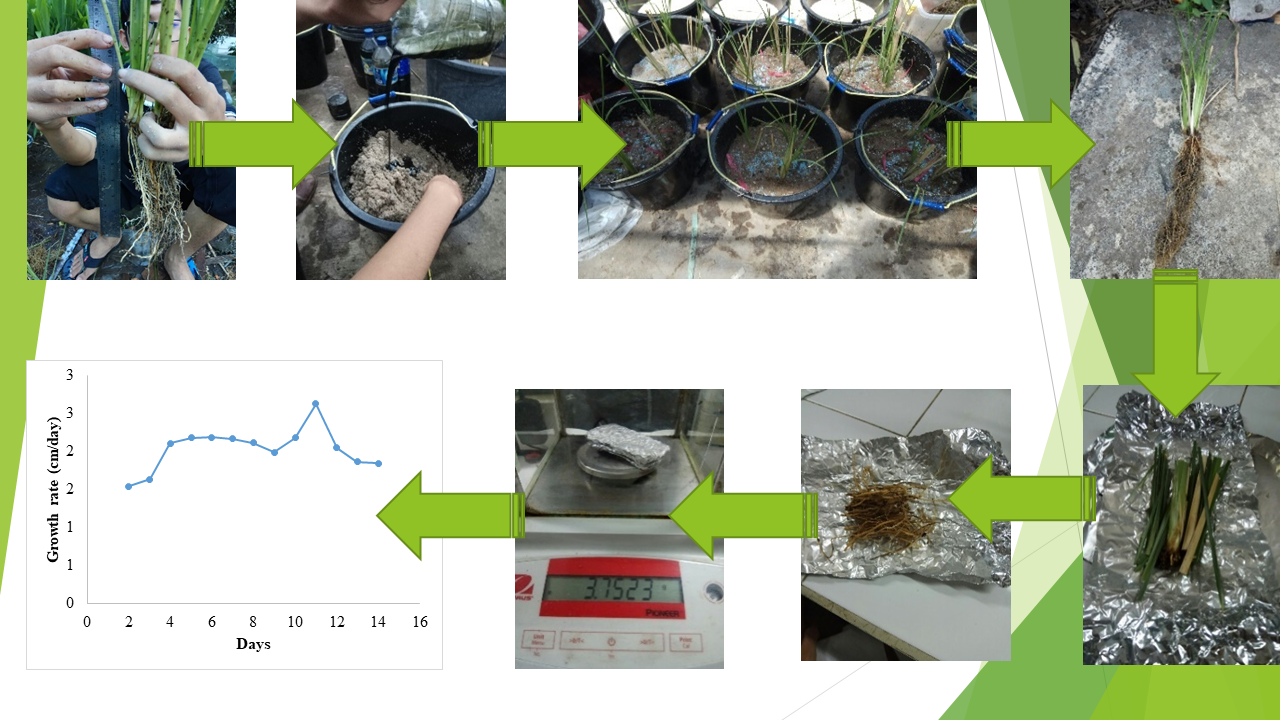Range finding test and measurement of wet weight and dry weight of Vetiveria zizanioides as an initial stage of phytoremediation of soil contaminated with used lubricants
DOI:
https://doi.org/10.14719/pst.1442Keywords:
Hyperaccumulator, Hydrocarbon, Rhizosphere, Soil pollution, VetiverAbstract
Environmental pollution caused by the development of industry and the rapid increase in the number of vehicles currently requires restrictions on the use of lubricants. Used lubricants contain complex mixtures of hydrocarbons that adversely affect plants by creating conditions that make essential nutrients such as nitrogen and oxygen needed for plant growth unavailable and cause severe problems in soil ecosystems and the rhizosphere. The accumulation of these spills can complicate the degradation process by microorganisms in the soil. Vetiver (Vetiveria zizanioides) can grow at various levels of nutrients and insufficient abiotic conditions, so it is used in multiple studies as a hyperaccumulator plant. Preliminary research in determining the concentration of used lubricant handled by the vetiver can be determined through the Range Finding Test (RFT) stage. RFT is the stage of observing the plant's ability to maintain its life while degrading pollutants. Physical observations and laboratory analysis determine how strong the plants live in media contaminated with used lubricant pollutants. The results showed that vetiver could live in an environment contaminated with used lubricants with a concentration of up to 4% of the total mass of the media (40 ppm). Sample C2 had an average growth rate of 0.481 cm/day with a root elongation ratio of 0.333. The average dry fraction of plant leaves is 0.602 and the root is 0.372.
Downloads
References
Simeon Oluwatoyin A, CO Akaeze. Genotoxic evaluation and toxicity of spent engine oil on clariasgariepinus. Res J Environ Toxicol [Internet] 2012; 6(4): 133-41. https://doi:10.3923/RJET.2012.133.141.
Be U, N Bo. Characterization of soil health using microbial community and maize germination as bioindicators in oil-contaminated soil. J AdvDevRes [Internet] 2011; 2(2): 191–97. https://doi:10.1016/j.apsoil.2005.01.003.
Murakami CJ, V Wall, N Basisty, M Kaeberlein. Composition and acidification of the culture medium influences chronological aging similarly in vineyard and laboratory yeast. PLoS One [Internet] 2011; 6(9):. https://doi:10.1371/JOURNAL.PONE.0024530.
Kuo HC, DF Juang, L Yang, WC Kuo, YM Wu. Phytoremediation of soil contaminated by heavy oil with plants colonized by mycorrhizal fungi.Int J Environ SciTechnol [Internet] 2014;11(6):1661–68. https://doi:10.1007/s13762-013-0353-6.
Greenfield J. Vetiver grass: an essential grass for the conservation of the planet earth. 2002. Accessed: Dec. 21, 2021. [Online]. Available: https://www.cabdirect.org/cabdirect/abstract/20023165798
Soemirat J. ToksikologiLingkungan. YogyRootta (ID): Gajah Mada University Press. 2003.
Gerhardt KE, XD Huang, BR Glick, BM Greenberg. Phytoremediation and rhizoremediation of organic soil contaminants: Potential and challenges. Plant Sci. [Internet] 2009;176(1):20–30. https://doi:10.1016/j.plantsci.2008.09.014.
Shipley B, TT Vu. Dry matter content as a measure of dry matter concentration in plants and their parts.New Phytol. [Internet] 2002; 153(2): 359–64. https://doi:10.1046/J.0028-646X.2001.00320.X.
Arliyani I, B Tangahu, S Mangkoedihardjo. Performance of reactive nitrogen in leachate treatment in constructed wetlands. J EcolEng [Internet] 2021; 22(5): 205–13. https://doi:10.12911/22998993/135314.
Lugtenberg B, FK-A review of microbiology, undefined 2009. Plant-growth-promoting rhizobacteria.annualreviews.org [Internet] 2009; 63 541–56. https://doi:10.1146/annurev.micro.62.081307.162918.
Miransari M. Plant growth promoting rhizobacteria. J Plant Nutr.[Internet] 2014; 37(14): 2227–35. https://doi:10.1080/01904167.2014.920384.
Nurmalasari R, BV Tangahu. Bioremediation of soil contaminated diesel using symbiotic bacteria with bioremediation of soil contaminated diesel using symbiotic bacteria with nutrient variation concentration., in 11th International Conference on Advances in Agricultural, Biological, Civil and Environmental Sciences. 2020, 18(20):, 44–51. Accessed: Dec. 21, 2021.[Online]. Available: http://dirpub.org/images/proceedings_pdf/DIR0118215.pdf
Ardhanie PR. BiodegradasiOliBekasPada Media Tanah.TugasAkhirJurusanTeknikLingkungan, FTSP, ITS Surabaya. 2003

Downloads
Published
Versions
- 01-04-2022 (2)
- 26-01-2022 (1)
How to Cite
Issue
Section
License
Copyright (c) 2021 Bieby Voijant Tangahu, Alif Yoga Winata; Isni Arliyani

This work is licensed under a Creative Commons Attribution 4.0 International License.
Copyright and Licence details of published articles
Authors who publish with this journal agree to the following terms:
- Authors retain copyright and grant the journal right of first publication with the work simultaneously licensed under a Creative Commons Attribution License that allows others to share the work with an acknowledgement of the work's authorship and initial publication in this journal.
- Authors are able to enter into separate, additional contractual arrangements for the non-exclusive distribution of the journal's published version of the work (e.g., post it to an institutional repository or publish it in a book), with an acknowledgement of its initial publication in this journal.
Open Access Policy
Plant Science Today is an open access journal. There is no registration required to read any article. All published articles are distributed under the terms of the Creative Commons Attribution License (CC Attribution 4.0), which permits unrestricted use, distribution, and reproduction in any medium, provided the original author and source are credited (https://creativecommons.org/licenses/by/4.0/). Authors are permitted and encouraged to post their work online (e.g., in institutional repositories or on their website) prior to and during the submission process, as it can lead to productive exchanges, as well as earlier and greater citation of published work (See The Effect of Open Access).









